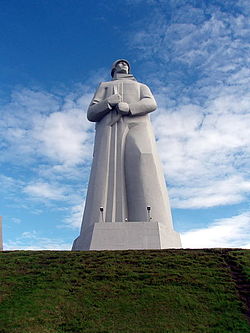- Defenders of the Soviet Arctic during the Great Patriotic War
-
Defenders of the Soviet Arctic during the Great Patriotic War 
Alyosha of MurmanskLocation Murmansk, Russia Designer I. A. Pokrovsky (architect)
I. D. Brodsky (sculptor)Type large statue Height 35.5 metres (116 ft) Opening date October 19, 1974 Coordinates 68°59′35″N 33°04′18″E / 68.99306°N 33.07167°ECoordinates: 68°59′35″N 33°04′18″E / 68.99306°N 33.07167°E Defenders of the Soviet Arctic during the Great Patriotic War (Russian: Защитникам Советского Заполярья в годы Великой Отечественной войны), commonly called Alyosha (Russian: Алёша; Alyosha is an affectionate diminutive form of the name Alex) is a monument in Murmansk, Russia to Soviet soldiers, sailors, and airmen of World War II (called, in Russia, the Great Patriotic War).
Contents
Description
The statue is of a soldier in a greatcoat with a rifle slung over his shoulder. The height of the pedestal is 7 metres (23 ft); the statue is 35.5 metres (116 ft) tall.[1] It is the second-tallest statue in Russia, after The Motherland Calls in Volgograd. The weight of the statue, which is hollow, is over 5,000 tons. The soldier faces west, toward the Valley of Glory, where the fiercest fighting of the Actic Campaign occurred when the German invaders were turned back from the approaches to Murmansk at the Zapadnaya Litsa River in July of 1941.
In front of the monument is a platform of natural black stone bearing an eternal flame. A little higher and closer to the statue is a sloping triangular pyramid. According to the designers, this pyramid represents a flag at half–mast as a sign of mourning for the fallen soldiers of the red banner. Next to the statue is a stele of polished granite with this inscription:
Slightly to one side of the monument are two anti–aircraft guns. (During the war, anti–aircraft guns were emplaced at the site as part of the air defense of Murmansk.)[1] Built into the foot of the monument are two capsules, one with seawater from the gravesite of the heroic patrol craft Tumen which sank while fighting off three German destroyers[A], one with earth from the Vally of Glory and from the Verman River front.
A large central staircase leads up to a podium used by speakers during ceremonies at the monument. Completing the complex is a mall built in 2004 with plaques commemorating the other hero cities.
History
The first plan was to build the monument at Five Corners, the main square of Murmansk, but it was later decided to build it on a hill overlooking the city and Kola Bay at Cape Green in the Leninsky District. Collection of funds for the project was initiated by a floating workshop collective named "Chisel". Ground was broken on October 17 1969 and construction began in May of 1974.
The monument was dedicated on the 30th anniversary of the defeat of German forces in the Arctic – October 19th, 1974. At the opening ceremony, a column proceeded to the site, with two armored personnel carriers at the head and at the rear a gun carriage with the remains of an Unknown Soldier and the two capsules, one of water and one of earth. Standing on the roads in Kola Bay, the cruiser Murmansk saluted with 30 volleys in honor of the holiday and the opening of the memorial.
On May 9, 1975, the Unknown Soldier was reburied in a solemn ceremony at the eternal flame at the foot of the monument.[1]
In October 2004, the 60th anniversary of the victory of Soviet forces in the Arctic, a memorial plaque and capsule containing earth from the other hero cities was installed at the mall of the hero cities.
References
- This article incorporates information from the equivalent article on the Russian Wikipedia.
- Vladimirova, T., ed (2004). Памятники города — героя Мурманска [The Monuments of the City - Heroic Murmansk]. Murmansk. (Russian)
- ^ a b c Maria Dmitrash. "'Алеша' – мемориал защитникам Заполярья ['Alyosha' – memorial to the defenders of the Arctic]". Seven Wonders of Russia. http://www.ruschudo.ru/miracles/81/. Retrieved October 18, 2011. (Russian)
External links
- The Monument to the Defenders of the Soviet Arctic at "Birds-Eye Views of Wonders of Russia" (video) (Russian)
Notes
- ^ The Tuman ("Mist"; Russian: Туман) was sunk on August 4, 1941, at 69°33′06″N 33°40′20″E / 69.55167°N 33.67222°E; Russian naval ships passing over the site dip their flags and sound their horns in commemoration.
Categories:- Murmansk
- Outdoor sculptures in Russia
- World War II memorials in Russia
- 1974 establishments in the Soviet Union
- Buildings and structures completed in 1974
Wikimedia Foundation. 2010.
